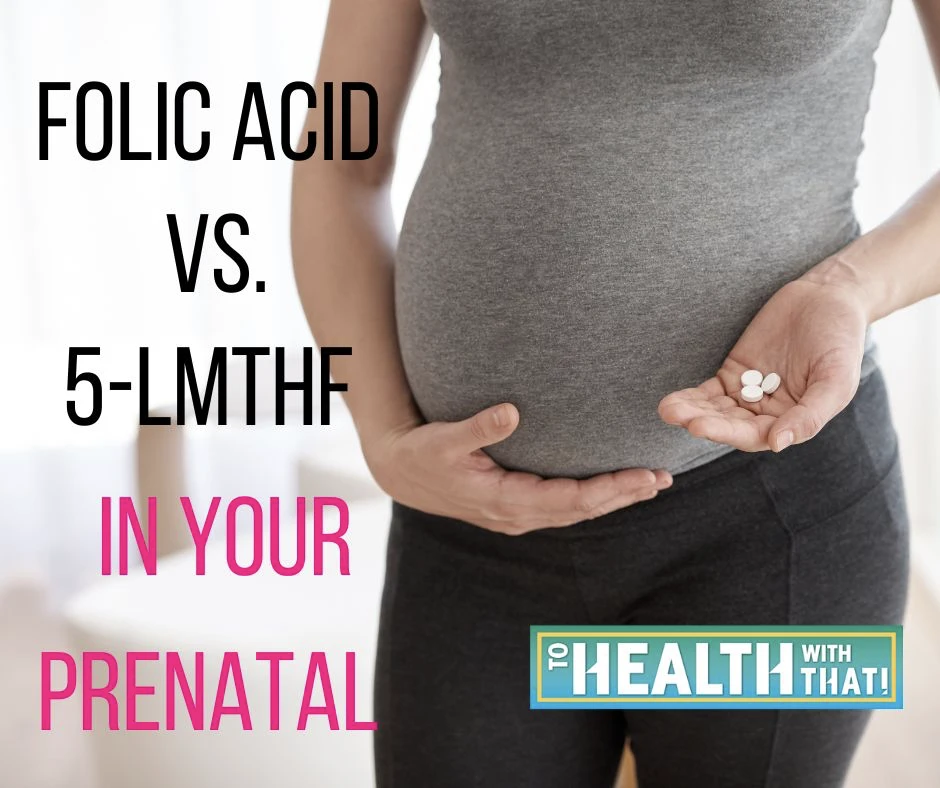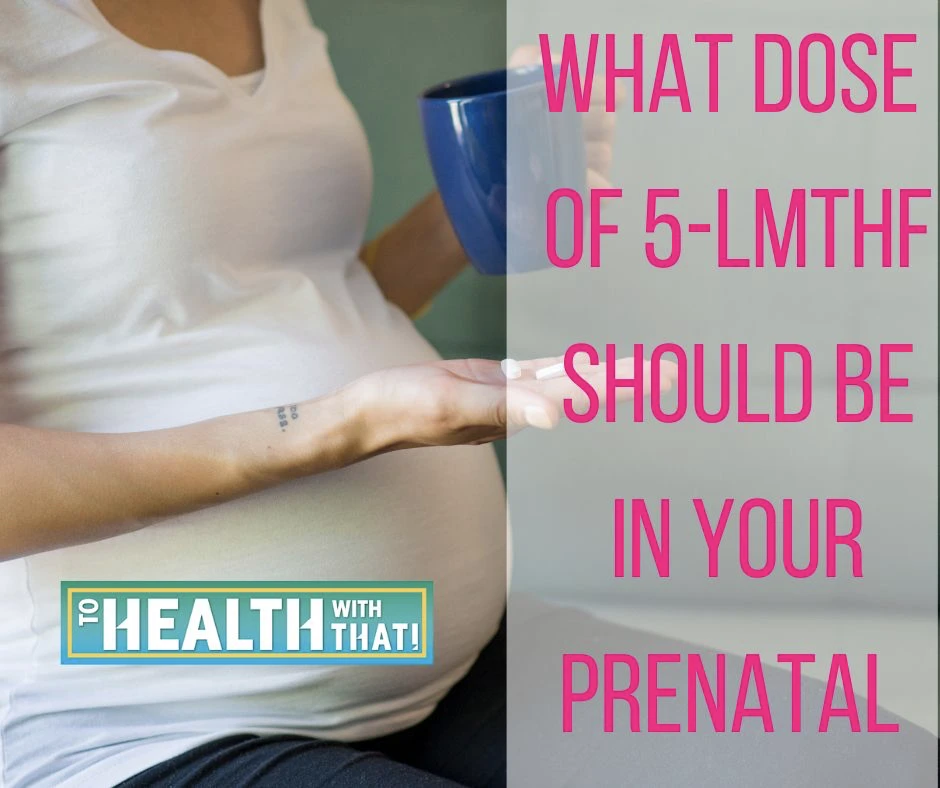5MTHF vs. Folic Acid in Your Prenatal
- Dr. Amy Neuzil, Methylation and MTHFR Expert

- Dec 29, 2022
- 5 min read
Updated: Oct 24
This idea that methyl folate could be a better option than folic acid in prenatal vitamins is controversial, because folic acid has been the fertility go-to treatment since it was discovered in the 1930s. The issue is, MTHFR had NOT been discovered in the 1930s, and so the research wasn't able to get into the genetic needs of infertile couples yet. The great news is that it is starting, and there are some very relevant pieces of information for couples in which one or both partners have an MTHFR gene variance. So, let’s talk about folic acid vs. 5-LMTHF in women and men with and without the MTHFR polymorphism. If you are struggling with fertility, I recommend printing out the studies used in the references and taking them with you to your OB/GYN or midwife.
This is an area with very little research and at the start I would like to say that 5,000 mcg of folic acid as an intervention for repeat pregnancy loss is very successful and has helped thousands of couples get to baby-in-arms. That is an amazing thing, and so, as a first step for people without a known MTHFR polymorphism, this can be a really great intervention.
Where I want to talk about doing something differently is when couples are still having fertility issues after trying and failing with 5,000 mcg folic acid, or when one or both parties have copies of an MTHFR mutation. If you or your partner have an MTHFR gene mutation, then questioning 5MTHF vs. folic acid in your prenatal becomes incredibly important.
The most important piece of research to take to your midwife or fertility practitioner is a study published in the Journal of Assisted Reproduction and Genetics in 2018, which very clearly answers the question of which form of folate is better for couples with MTHFR. In this study, 5MTHF vs. folic acid in your prenatal is clear because 5MTHF helps couples get pregnant where folic acid fails.
This study followed 33 couples in which one or both of the partners had an MTHR polymorphism who had fertility problems lasting at least 4 years. You’ll notice that these folks are really well established in their fertility journey and have been trying for a very long time. Their fertility issues included recurrent fetal loss, premature ovarian failure, and abnormal sperm parameters. Bear in mind, it could be the mother or the father who has MTHFR issues. Two-thirds of these couples had previously failed assisted reproductive technology attempts, which means they tried and failed procedures like in-vitro fertilization.
Most of the women in this study had been previously treated, unsuccessfully, with 5000 mcg (or 5 mg) folic acid. This is really important because we don’t necessarily want to skip over this step.
Everyone in this study, male and female partners alike, were given 600 mcg 5MTHF (or methyl folate), which is the active form of folate, for four months before attempting conception or starting another round of assisted fertility treatment. This four-month period was chosen to allow for a complete cycle of new sperm growth, or spermatogenesis, which is approximately 74 days.

What Happened When Couples Switched from Folic Acid to 5-LMTHF?
The results of this one simple intervention were, in my opinion, absolutely astounding. Of the 33 couples:
2 were still in treatment at the date of reporting.
13 couples conceived spontaneously (this is after four years of unsuccessful reproductive attempts)
14 achieved successful pregnancies using ART (assisted reproductive technology). ART typically refers to IVF or in-vitro fertilization.
3 couples did not achieve successful pregnancies.
1 couple failed to report back.
This means that after they got away from folic acid and switched to prenatals with 5MTHF for four months, 27/33 couples got pregnant after four years of infertility struggles. The only thing they did differently was switch from folic acid to 5MTHF.
Here is the conclusion of this study, verbatim, because there is no way to say it better.
The conventional use of large doses of folic acid (5 mg/day) has become obsolete. Regular doses of folic acid (100–200 μg) can be tolerated in the general population but should be abandoned in the presence of MTHFR mutations, as the biochemical/genetic background of the patient precludes a correct supply of 5-MTHF, the active compound. A physiological dose of 5-MTHF (800 μg) bypasses the MTHFR block and is suggested to be an effective treatment for these couples. Moreover, it avoids potential adverse effects of the UMFA syndrome, which is suspected of causing immune dysfunction and other adverse pathological effects, such as cancer (especially colorectal and prostate).
For MTHFR Mutants, the Question of 5MTHF vs. Folic Acid in Your Prenatal is Easily Answered. So What is the Optimal Dosage of 5-LMTHF in a Prenatal?

The most startling result of this research, I feel, is the tremendous number of couples who conceived spontaneously after a simple few-month low-dose intervention with 5-LMTHF.
In terms of amounts - it is hard to say if this low 800 mcg dose is really the optimal dose during pregnancy for 5-LMTHF because that research hasn’t been done yet.
Most prentals on the market that contain 5-LMTHF have a 1000 mcg dose, which is a good compromise between the 600 mcg folate recommended daily in pregnancy, and the whopping 5000 mcg dose often given in situations of repeat pregnancy loss or difficulty conceiving.
Some OB-GYN and midwifery teams are still unfamiliar with the use of 5-LMTHF in pregnancy, and talking seriously with them and presenting them with this research as a basis for your conversation will help them to see your point of view and encourage them to walk down this path with you as a viable alternative treatment - especially if you have already tried 5,000 mcg folic acid.
What About UMFA?
UMFA stands for unmetabolized folic acid, and it's a risk when using a high-dose folic acid intervention, but not with methylfolate. Research published in the American Journal of Clinical Nutrition in 2020 has linked high levels of UMFA in pregnant mothers to increased risk of autism in their unborn children. UMFA has been detected in all age groups in the US, in part due to food fortification programs, and so it is important to understand your risks and be aware of how much fortified food you take in. If you have an MTHFR mutation, it is best to avoid foods fortified with folic acid and all other sources of folic acid completely.
References
Servy EJ, Jacquesson-Fournols L, Cohen M, Menezo YJR. "MTHFR isoform carriers. 5-MTHF (5-methyl tetrahydrofolate) vs folic acid: a key to pregnancy outcome: a case series." Journal of Assisted Reproduction and Genetics. 2018 Aug;35(8):1431-1435.
To find and download this study to take to your provider, click here.
Raghavan R, Selhub J, Paul L, Ji Y, Wang G, Hong X, Zuckerman B, Fallin MD, Wang X. A prospective birth cohort study on cord blood folate subtypes and risk of autism spectrum disorder. Am J Clin Nutr. 2020 Nov 11;112(5):1304-1317.
To find and download this study to take to your provider, click here.

Comments